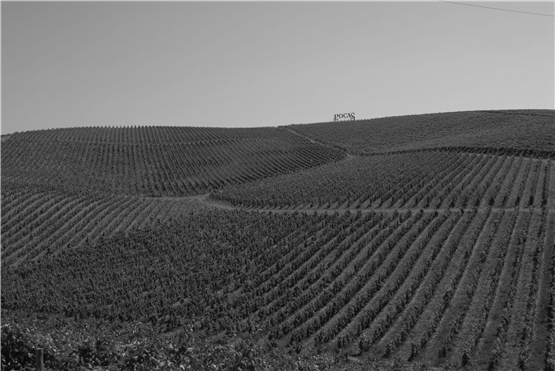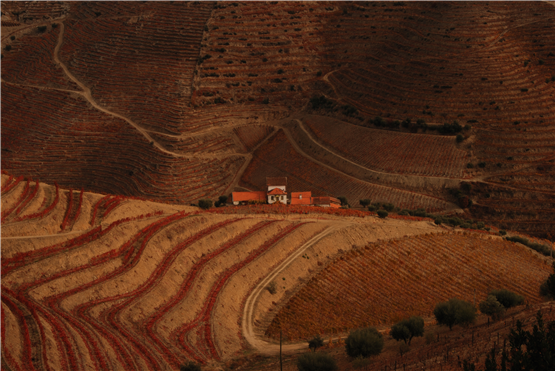

In 1918, 30-year-old Manoel Domingues Poças Júnior decided to start his own Port enterprise. He already had a large amount of experience of the Port industry, having been born in the hustle and bustle of it all coupled with strong family ties to fortified wine production. Initially, Manoel and his uncle concentrated on selling grape juice to Port wine shippers or larger Port wine houses, which consolidated their knowledge and qualified them to be real experts of the trade.
They opened their first office in Nova de Gaia soon after, premises that have served them well, remaining their Head office to this day, as well as being home to a renowned Port wine cellar. The farms first Vintage Port was not released until 1962, Manoel showed inspiring dedication to reach this milestone. He visited his Quinta weekly and due to the fact there was no road leading up to the Estate, he had to walk the rocky paths for 700 metres to reach his beloved Quinta. A road was only constructed after Manoel passed away, despite his dreams of being able to drive to it directly.
Now onto their Fourth generation of Pocas, Maria Manuel Maia has been at the head of operations since 2020, having directed Viticulture since 2005. She has headed a move towards developing other styles of unfortified wines alongside Port production. In 1990, the demand for Port was still decreasing, they made the decision to try new techniques and started producing high quality dry and unfortified red, white and orange wines. Fora da Série, as the alternative project was named, has been exceedingly successful in showcasing Portugal’s flexibility in wine style and has allowed them to develop their brand further than ever imagined since starting in 1918.
She manages the three family Estates (Quintas) in the most prestigious areas within the Demarcated Douro region. In Baxio Corgo there is Qunita das Quartas, attained in 1932 as debt payment. In Cima Corgo they have the Quinta de Vale Calvados, acquired from Douro Superior in 1988, and in 1999 Quinta Santa Barbara was added to their impressive consortium. Quinta das Quartas is the wine-making centre and includes a museum showcasing the primitive granite wineries founded in 1873. In excess of 2.50 hectares of vineyard, it really stands out from the crowd, boasting a large aging cellar. It is here they are able to rest up to 25,000 hectolitres in wooden hulls, from half-pipes of 267 litres, to balers of 88,000 litres. In the modern Quinta, post 1996, the productions of all Poças farms have been produced here, totalling 1.1 million litres of wine!
Quinta de Santa Bárbara is in Upper Corgo and enjoys 33 hectares of vineyards with a large proportion being older vines producing some of the best Vintage and LBV Ports. The Quinta was named de Santa Bárbara after an old farmhouse, situated near the city of Peso da Régua, with a chapel of the saint and a spectacular view. It is also home to a beautiful walled orange grove, a much loved feature within their collection of Vineyards. Finally, the Quinta de Vale de Cavalos is located in Upper Douro next to the river Teja in Numão, a region of great prestige. This site is characterised by some important features. A higher altitude which allows a more intense flavour through the final product; this occurs by taking advantage of the larger diurnal range from increased sunlight during the day but cooler temperatures at night. The soil is schist and granite. The schist, comprised of hard, dense rocks that are layered with minerals, retain heat well. The granite soil tends to have a high pH level and is very porous, promoting acidic retention in the grapes. The vineyard is around 51 hectares and divided into a few plots including; Ribeira Teja, Zoc, Tanque and Catapereiro. There is a very sophisticated ‘drip irrigation’ system here, created out of necessity because of the region’s susceptibility to drought.
Sustainability is at the heart of their mission as Maria is a firm believer in the unique attributes found in the vineyards of the Douro, most notably it’s rich terrain. She operates agricultural practices with an authentic respect for nature, using natural resources and also implementing natural control mechanisms. These include planting of hedges and deploying cattle for controlling any weed growth. Her efforts in this area have meant Numão and Ervedosa do Douro have been certified as agriculturally integrated production systems since 2013. With a passion for the art of wine-making that is continuously reinforced by its successes in evolving its approach to meet the demands of an increasingly wider audience they have celebrated 100 years of excellence and look to celebrate 100 more!


Our suppliers come from all around the world, but they share one common goal – quality.